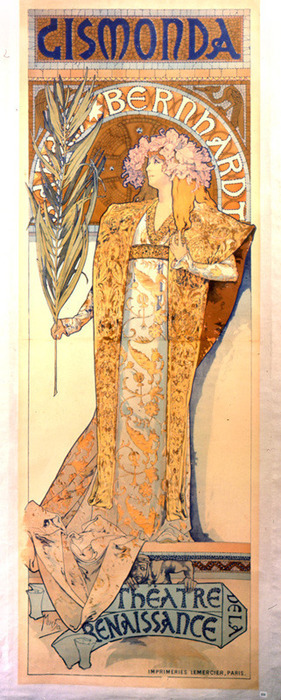
July 24th, 2010, is the 150th anniversary of the birth of the renown Czech artist Alphonse Maria Mucha. Mucha is known for his works in several mediums in the Art Nouveau style, which he helped to popularize around the end of the 19th century.
The work that first brought him fame was a poster of the actress Sarah Bernhardt for the play Gismonda (seen here). Its creation story is that on Christmas Eve, 1894, Mucha was doing a favor for a friend, a printer, correcting proofs. On that day Bernhardt contacted the printer with a request for a new poster for her play, which she needed as soon as possible. All the printer’s artists were on holiday, so Mucha volunteered to create the poster. Bernhardt was the queen of celebrities in her day and her wishes were quickly addressed.
The resulting poster, which Mucha created in two weeks, was an instant success and revolutionized poster design. The long narrow shape, the subtle pastel colors and the stillness of the near lifesize figure introduced a look that was quite novel for the time. The poster was so popular with the Parisian public that collectors were known to bribe the laborers who hung them to hand them over, or simply to go use razors to cut them down from the walls. Bernhardt was so satisfied with the poster she gave Mucha a muli-year contract to produce stage and costume designs as well as posters for her.
After that, his posters, panneaux decoratifs, calendars, prints, magazine and book illustrations attained enormous popularity. With his exquisite decorative motifs, abundance of ornamental pictorial elements, and beautifully graceful lines, his compositions shaped the the Art Nouveau style.
The “le style Mucha” became the pattern for a whole generation of graphic artists and draftsmen.
His hallmark was the idealized, stylized figure of a graceful woman, loosely but inseparably framed in an ornamental system of flowers and foliage, symbols and arabesques. As this was one of the most widespread pictorial motifs of the turn of the century, the Mucha Style became for a while to be regarded as synonymous with the whole Art Nouveau movement.
Mucha actually disliked the name “Art Nouveau”, or the idea that it was a movement, arguing that art was eternal and therefore could not be “noveau.” He insisted he derived his main inspiration from Czech artistic traditions, rather than subscribing to the doctrines of any particular school.
A hundred years later, Art Nouveau is still a wonderful visual stimulation.
No comments:
Post a Comment